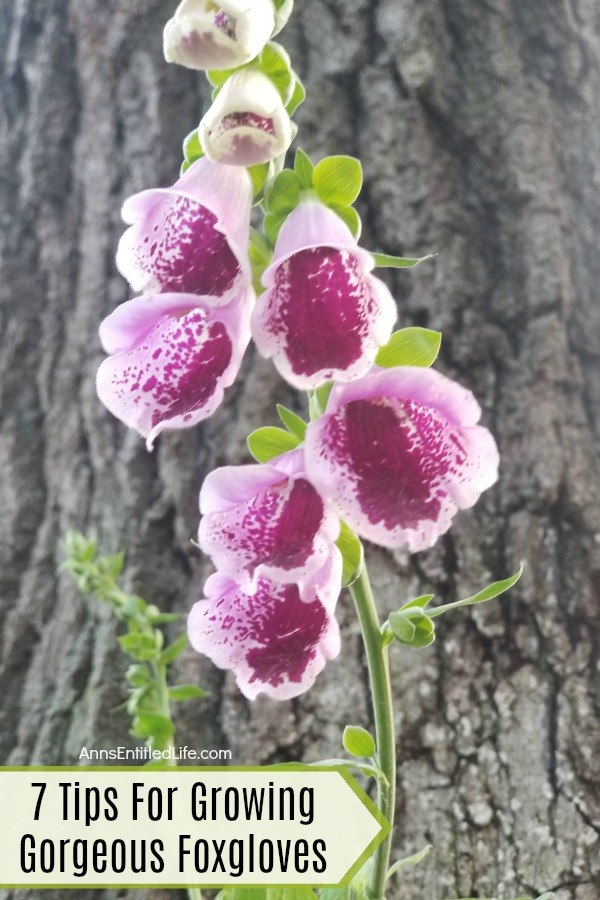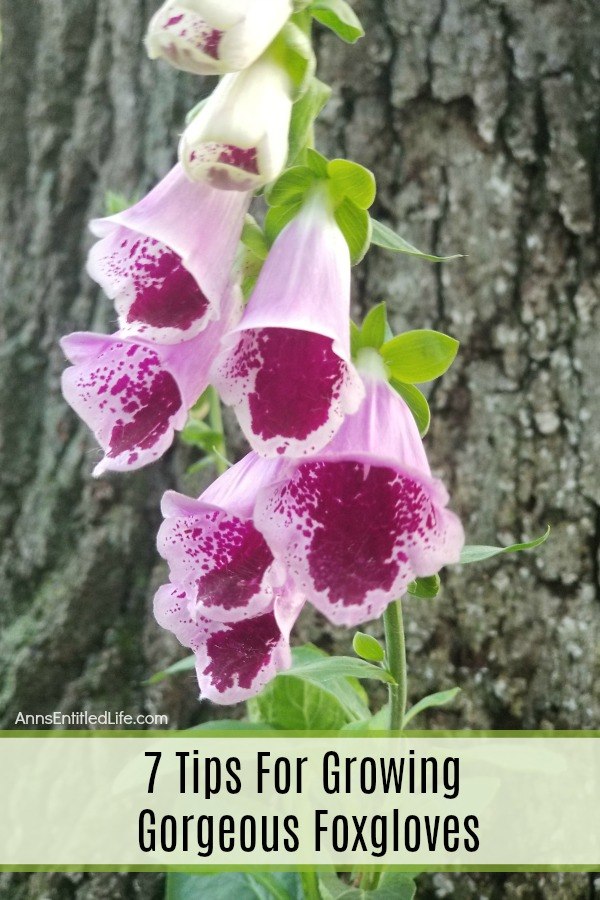Foxglove is a gorgeous, timeless plant that gardeners have enjoyed cultivating for years. Foxgloves bloom in a variety of colors and work hard at adding height and interest to your gardens. If you are curious about growing this beautiful perennial, take a look below at some helpful tips on how to grow foxglove for yourself. Here is what you need to know.
Foxglove Flowers: 7 Tips For Growing Gorgeous Foxgloves
I love, love, love the look of foxglove. Truly a unique and beautiful flower. Foxgloves come in many varieties, one just right for your growing area!
Foxglove is a poisonous plant if swallowed, so be mindful of that when choosing to plant. Note that this makes them a great flower to plant if you have a lot of deer (I call deer suburban rats because we have so many in our area). The deer know they are poisonous if ingested, and will not eat them.
Foxgloves look gorgeous in vases. If you wish to use your flowers in a cutting garden, create a separate planting area. If you cut the blooms they are less likely to come back the following year. Many gardeners like to add foxgloves to landscaping and borders, but only cut the blooms in their designated cutting garden so not to hurt their landscaping.
1. Watch Sunpatterns When You Plant Foxglove
Before you plant your foxglove, you should take note of where the sun falls in your garden. Foxgloves need full sun, at least six hours per day. They also do best with afternoon sun, so choose a space in the yard that enjoys direct midday sun.
2. Choose Well Draining Soil to Plant Foxglove
Foxgloves do not like “wet feet.” Wet feet means that the soil where your foxgloves are growing should not be soggy. You must take care to choose a planting area that is well draining. While there is nothing wrong with moist soil, you do not want to plant in any area that retains water or is muddy after a rain. Foxgloves are pretty low maintenance plants but they are susceptible to fungus when overcrowded and in poorly draining soil. Avoid this by not overcrowding, and planting in well-drained soil. If your foxgloves do develop a fungus, make sure to remove the infected plants.
3. Stake Your Foxglove Blooms to Prevent Breakage
Did you know that some varieties of foxgloves can grow up to 6 feet tall? As they grow and bloom, the stems may need some support. Simple stake systems can help give the plant some support. All you need is a simple bamboo stake and some string to easily offer support. If your foxgloves are not the tall variety, you will not need to stake.
4. Give Your Foxgloves Two Inches of Water Per Week
Foxgloves like regular watering, just do not overdo it. About two inches of water per week will do, and you will find that in many climates this can be achieved through regular weekly rainfall.
5. Do Not Deadhead Foxglove Blooms
Lots of plants can be strengthened and encouraged to grow further flowers when you deadhead old blooms. Foxglove is not one of those flowers. Foxglove actually relies on the dead blooms to reseed itself, so do not remove them. Instead, let the dead blooms fall of naturally and fall to the ground and reseed.
6. Mulch Your Foxgloves
Mulch helps keep the weeds under control, retain needed moisture without being soggy, and promotes even soil temperature. When using organic mulch, the breakdown will feed the soil. If you mulch your foxgloves after the ground freezes, it will help prevent heaving. You should remove the mulch when new growth appears in the spring.
7. Divide Foxgloves as Needed
Foxgloves can multiply and spread, especially if you have allowed the blooms to naturally fall and reseed. If you notice crowding, it may be time to thin the squad! Simply dig up from the root and replant to a well-draining, full sun area. Foxglove plants are quite valuable, so you may be able to trade your divisions with other gardeners to get additional plants you may need.
Are you ready to give foxgloves a try? Consider these tips for how to grow foxglove and see what a fun plant this can be!
Read more home gardening flower tips:
● Sunflowers: 7 Creative Uses for Sunflowers
● How to Grow and Care for Wisteria
● Everything You Need to Know to Grow Peonies
● For more Gardening posts on Ann’s Entitled Life, click here.
● Enjoy this post? Sign up for the Ann’s Entitled Life FREE Weekly Newsletter to stay connected.


Ellen Hawley says
I’m spoiled. I live in Cornwall and foxgloves plant themselves, grow themselves, and are completely beautiful. Every so often, a few decide to call our garden home. I do nothing except say thanks.